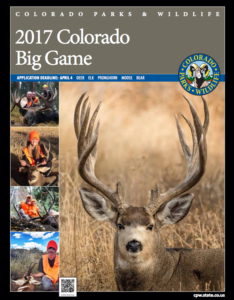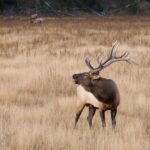Tyler Miller – Birmingham, AL : We enjoyed a great time at Wild Skies while out on a 7 day elk hunt. The accommodation were extremely comfortable and we had plenty of room for the four of us during our stay. While we chose to hunt off horseback we found the amenities at Wild Skies were great and allowed us to keep the horses, feed and tack on the property and allowed quick and easy access to the mountain. We made some lifelong friends during our hunt and harvested two 6X6 bulls in the process. Thanks again Wild Skies. We look forward to another hunt.
Come Hunt With Us!
With more than 23 million acres of public land, Colorado is an outdoor enthusiast’s paradise.
Colorado Hunting: What To Expect
Most of Colorado's hunters hunt elk, so if you are ever going to see an elk in your lifetime, you can surely expect that the odds are in your favor. If you have never hunted Colorado before, then we suspect that you are probably on cloud nine.
Hunting in Colorado is physically challenging, so expect to get tired, winded, have achy muscles, blistered feet, and sunburnt. That being said, we offer lots of advice on the website to either mitigate those effects or what to do when you suffer from them. So, heed the advice offered or suffer the consequences. Just remember, whatever the extent of the pain, you can always heal up after you get home.
Hunting Colorado's big game means one must be willing to compromise quickly and adjust to changes. The animals and weather will dictate your hunting options and will force changes upon you in the blink of an eye, so being flexible is a great asset.
<h4>Colorado Hunting: DIY Hunting</h4>
Do-It-Yourselfers make up the vast majority of Colorado's hunters, and most of those hunt elk. DIY hunting is probably the biggest thrill one can have, but it can also be one of the biggest challenges.
Unless you are a seasoned Colorado hunter, we suggest you keep things simple: hunt one species of animal, two at the most. For example, hunt bull elk only or get an either sex elk tag. Or, if you've already killed an elk in a previous year, then go after a mule deer. The point is, whatever animal gets your blood pumping, go after that animal only. Don't spread your interests thin by throwing multiple tags into the mix. However, if you do have multiple tags, then know how to concentrate your efforts to maximum advantage. For example, let's say you have tags for elk and black bear. In this case, concentrate all your efforts on the elk. If you're blessed with getting one, then hunt over the gut pile for your black bear.
Colorado Hunting: Maps
To hunt in Colorado means one must study maps. Nowadays, with the use of GPS and mapping programs, you can just about find any type of mapping system that fits your needs. Our recommendations: learn to read maps, declination, GPS and compass, longitude (long) and latitude (lat). Don't bother with UTMs because most coordinates are provided via long and lat. However, if you get lost, you may want to know how to easily convert long/lat to UTM because that is the system that some search and rescue teams use.
Maps come in various topographical scales that determine the extent of detail. For example, a typical BLM map is 1:100,000 scale, which basically means that each centimeter on the map equals one kilometer on the ground. For those of us who aren't exactly up with the metric system, one inch on the map would equal 1.58 miles on the ground. Obviously, this scale doesn't provide much detail. The most popular map is the 1:24,000 scale, which is also known as the 7.5 minute series or quadrangle. This scale works out to be 6 2/3 football fields or 667 yards per inch on the map, which means a lot of detail. <a href="https://flattopshunting.com/flat-tops-cabin/directions-maps/" rel="noopener noreferrer"><strong>Buy custom hunting maps</strong></a> with elk overlays on them.
Unlike many states, Colorado is laid out in a North-East-South-West grid, which makes it much easier to follow property lines. Since all maps don't show private property, you may need to have more than one map. Original survey markers in Colorado, which are not vastly numerous, were used to provide the theoretical geographical coordinates statewide. So, a good rule of thumb is to assume that coordinates provided by any source are only approximate and you should leave a buffer between you and private property. If you are using a GPS to track your line of travel, please note that each "second" of longitude or latitude is approximately 100 feet on the ground.
Fluorescent Pink Approved!
In the spring of 2016, Colorado legislature passed Senate Bill 16-068 concerning wearing fluorescent pink garments to hunt big game. This change went into effect August 10, 2016.
Find out what this means for hunters. For details about this alternative hunter safety color, please read the Authorized Fluorescent Pink fact sheet.
Check out Colorado Parks & Wildlife’s Big Game – What’s New in 2017 Video here.
Colorado Hunting: GMUs
The whole state of Colorado is divided into Game Management Units (GMUs), the boundaries of which are defined by roads, rivers, drainages and mountain ridges for the purpose of managing wildlife in geographically differentiated areas.
Tag Options
Colorado is the only state that still offers “unlimited” over-the-counter bull elk tags, which allows you to hunt a bull elk in most of the state’s GMUs just by applying for it. Other than that, it’s pretty much by draw only unless you apply for an over-the-counter bear tag which is a limited license only available when you have a valid deer or elk license for the same season. It is limited which means tags are on a first-come first-served basis until a specific number is reached.
For someone that may have missed the drawing, and depending upon the GMU, there may be some leftover tags.
 If you are a Colorado resident, another option is to participate in a draw for private land hunts via Ranching For Wildlife (RFW). Private ranches with at least 12,000 acres may partner up with the Colorado Division of Wildlife to provide Colorado hunting opportunities to help manage game on large tracts of private land. Currently, there are over one million acres of available hunting land in the RFW program.
If you are a Colorado resident, another option is to participate in a draw for private land hunts via Ranching For Wildlife (RFW). Private ranches with at least 12,000 acres may partner up with the Colorado Division of Wildlife to provide Colorado hunting opportunities to help manage game on large tracts of private land. Currently, there are over one million acres of available hunting land in the RFW program.
CONTACT US

If you have questions or would like to check availability, call 970.926.0216
or complete the contact form.